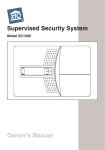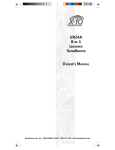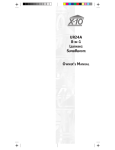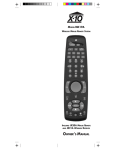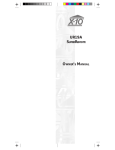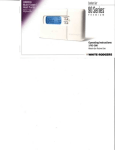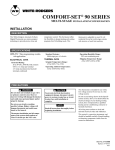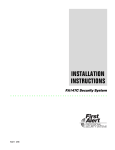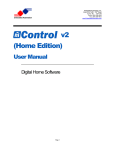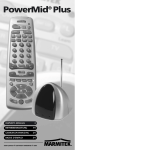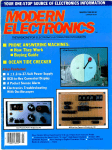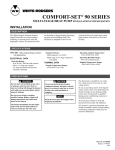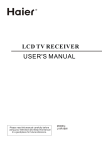Download X10 Wireless Technology UR86A User's Manual
Transcript
WIRELESS MOUSEREMOTE MODEL UR86A OWNER’S MANUAL READ THIS FIRST! Safety Considerations Remember to exercise good common sense when using your X10 wireless MouseRemote for home automation applications. There can be some unexpected consequences if not used with care. For example, an empty coffee pot can be remotely turned on. If that should happen, your coffee pot could be damaged from overheating. If an electric heater is turned on by remote control while clothing is draped over it, a fire could result. DO NOT USE the system for the control of high power heating appliances such as portable heaters. Caution: To reduce the risk of electric shock, do not disassemble any part of the Home Automation System. No userserviceable parts are inside. If you spill liquid on any accessory unit (Modules, etc.) disconnect the unit from the AC outlet to prevent possible fire or shock hazard and consult authorized service personnel. Powerline operated equipment or accessories connected to any of these units should bear the UL listing or CSA certification mark and should not have been modified in any way that might defeat their safety features. Warning: To prevent electric shock hazard, do not expose any part of the Home Automation System to rain or moisture. FCC CAUTION THIS DEVICE COMPLIES WITH PART 15 OF THE FCC RULES. OPERATION IS SUBJECT TO THE FOLLOWING TWO CONDITIONS: (1) THIS DEVICE MAY NOT CAUSE HARMFUL INTERFERENCE, AND (2) THIS DEVICE MUST ACCEPT ANY INTERFERENCE RECEIVED, INCLUDING INTERFERENCE THAT MAY CAUSE UNDESIRED OPERATION. This equipment generates and uses radio frequency energy, and if not installed and used properly, that is, in strict accordance with the manufacturers instructions, it may cause interference to radio and television reception. It has been type tested and found to comply with the limits for remote control devices in accordance with the specifications in Sub-Parts B and C of Part 15 of FCC Rules, which are designed to provide reasonable protection against such interference in a residential installation. However, there is no guarantee that interference will not occur in a particular installation. If this equipment does cause interference to radio or television reception, which can be determined by unplugging the equipment, try to correct the interference by one or more of the following measures. • Reorient the antenna of the radio/TV experiencing the interference. • Relocate the interface with respect to the radio/TV. • Move the interface away from the radio/TV. • Plug the interface into an outlet on a different electrical circuit from the radio/TV experiencing the interference. • If necessary, consult your local Dealer for additional suggestions. NOTE: Modifications to any of the components in this kit will void the user’s authority to operate this equipment. 2 3 CONTENTS INTRODUCTION ................................................5 BATTERY INSTALLATION ..................................6 SETTING UP YOUR MOUSEREMOTE ..................7 B UTTON DESCRIPTIONS ........................... 7 B UTTON DEFAULTS ................................. 9 MOUSE OPERATION ............................... 10 SOFTWARE INSTALLATION ....................... 10 USB RECEIVER INSTALLATION ............... 10 MOUSE SOFTWARE CONFIGURATION ....... 11 T YPICAL APPLICATION S CENARIO ........... 15 SETTING UP FOR TV, VCR, CBL, AUX 16 USING AUX TO CONTROL A SECOND TV, VCR, OR CABLE BOX ................... 17 SEARCHING FOR CODES ........................ 18 IDENTIFYING CODES FOUND USING THE SEARCH PROCEDURE ...................... 20 LEARNING ............................................ 21 HOME AUTOMATION .......................................23 C ONTROLLERS AND MODULES ................ 23 HOUSE CODES AND UNIT CODES ........... 24 INSTALLING HOME AUTOMATION C OMPONENTS ....................................... 25 T RANSCEIVER MODULE ......................... 25 L AMP MODULE .................................... 26 CONTROLLING X10 MODULES ........................27 C HANGING THE X10 HOUSE CODE: ....... 28 C ONTROLLING AN IR M INI CONTROLLER 29 EXPANDING YOUR SYSTEM .............................30 TROUBLESHOOTING .......................................32 MOUSE RELATED P ROBLEMS ........... 33 SYSTEM REQUIREMENTS ................. 34 WARRANTY ...................................................35 4 INTRODUCTION Congratulations on your purchase of the X10 MouseRemote and Wireless Receiver. Wireless Mouse.... The UR86A remote control works with the wireless USB receiver (CM19A) or VGA Video Sender (VT37A). You install software for it from X10’s Web Site. The remote control sends wireless RF signals to the CM19A or VT37A which is connected to the USB port on your PC. This lets you use the remote as a wireless mouse. You use the mouse pad on the remote to move the cursor around the PC screen, and use the left and right mouse buttons just like you would on a regular mouse. There is also a “Drag” button that acts like you are clicking and holding the left mouse button. It’s that simple! The MouseRemote also lets you configure the remote’s special function buttons. You can configure these buttons to perform special functions such as launching your WEB Browser, for example. Universal Remote.... You can use the MouseRemote as a Universal Remote, to control most audio/ video products. Control your TV, VCR, Cable Box, Satellite Receiver, etc., all from the same convenient and easy to use remote. Make your lights and appliances go to work for you.... The X10 MouseRemote controls most or all of your video and audio equipment. But what really sets it apart from other universal remotes is that you can also control almost any light or appliance in your home - even in another room! And it’s easy to install. Within minutes, you can be using your X10 MouseRemote to dim the lights, start brewing a fresh pot of coffee and play your favorite movie! (Requires X10 Transceiver and Modules, sold separately). 5 Here are just some of the things you can do with your X10 MouseRemote... • Control your entire audio/video and lighting setup for the ultimate Home Theater experience. • Turn on lights at night to scare away intruders if you hear a noise. • Start the coffee from your bedroom when you wake up. SETTING UP YOUR MOUSEREMOTE BUTTON DESCRIPTIONS INDICATOR LIGHT The indicator light (LED) illuminates when a key is pressed (if the key is available in the selected mode). • Turn on your electric blanket before the movie ends, so it’s nice and warm when you go to bed. POWER Works in the same way as your original remote. Turns All Lights On in X10 mode. Use this manual to become familiar with your MouseRemote.... PC Press first to enable the mouse and PC functions. This manual will explain how to set up your MouseRemote to use it with your PC as a wireless mouse. S (SETUP) Used to set up the remote to control your TV, VCR, Cable box, etc. Next, it shows you how to set it up to control your existing Audio/Video equipment. TV, VCR, CBL, AUX Used to select the device you want to control. Next, it will show you how you can use it with an X10 Transceiver Module X10 Modules (sold separately) to operate electrical devices in your home. Finally, the manual will show how you can expand your system with some of the many additional X10 products you can purchase. Battery Installation 1. Push the tab and lift off the battery cover. X10 Lets you control X10 Modules to operate lamps and appliances around the home. (Transceiver, sold separately, is required). MOUSE PAD Moves the cursor around the screen. MOUSE BUTTONS, L AND R Used as left and right mouse buttons. HAND SYMBOL Used to drag a selection after clicking on it with the L mouse button. +/- (UP/DOWN) Works like your original remote. Also brightens and dims lamps in X10 mode. Works as Line Up/Down in PC mode. VOLUME +/- (UP /DOWN) Works like your original remote. Also works as On and Off in X10 mode. Also works as Page Up/Down in PC mode. CHANNEL 2. Insert four AAA alkaline batteries, taking care to match the + and marks in the battery compartment. 6 MUTE Works the same as your original remote. Turns All Modules off in X10 mode. 7 LEARN Used to learn codes from existing remotes. 0-9 Used as with your original remote and to enter device codes. Can also be configured to perform PC functions. ENT Used to confirm certain entries. A-B Used as a TV/VCR button. UP/DOWN/LEFT/RIGHT CURSORS Used to navigate menu functions OK Selects a function. MENU Used for menu selections on DBS receivers. EXIT Exits from the Menu function. A, B, C, D BUTTONS Special function buttons. PLAY, REW, FF, STOP, REC, PAUSE Work the same as on your original VCR remote. You must press the REC button twice to begin recording. Note that the mouse pad and the L, R, and drag buttons on the remote are only active after you press the PC button. They are not active in TV, VCR, CBL, AUX, or X10 modes. Note that the mouse cursor will move faster as you press and hold the mouse pad. To adjust mouse speed settings click on the RemoteMouse’s tray icon and select Configure. You can also configure the MouseRemote here to work with X10’s ShowTime™ digital photo viewer (sold separately). 8 The MouseRemote buttons can be programmed to perform various functions using X10’s MouseRemote software, but they are pre-programmed with the following defaults: When PC mode is selected the keys default to the following: Key PC mode Power 0 1 2 3 4 5 6 7 8 9 Ent A.B Close current application. 0 1 2 3 4 5 6 7 8 9 Return. Toggle between maximize and restore for current window. Up arrow Nudge mouse cursor up. Down arrow Nudge mouse cursor down. Left arrow Nudge mouse cursor left. Right arrow Nudge mouse cursor right. OK Return. Play Play, default player* Stop Stop, default player* FF FF, default player* REW REW, default player* Rec REC, default player* Pause Pause, default player* Vol+ Volume Up, default player* VolVolume Down, default player* Mute Mute, default player* Menu Bring up Windows Start Menu. Exit Esc (Escape). * The default player is Windows Media Player. 9 MOUSE OPERATION The UR86A MouseRemote works with the wireless USB receiver (CM19A). The remote control sends wireless RF signals (from up to 40 ft. away) to the receiver which is connected to your PC’s USB port. Or, if you already own X10’s ShowTime ™ PC to TV Photo Viewer, the VT37A that came with it, also acts as a receiver for the MouseRemote. CAUTION: Do not use both receivers at the same time. If you own ShowTime use the receiver that came with it and do not use the CM19A. You can also use the Drag button to act as if you were clicking and holding the left mouse button to move an object. It’s that simple! Note that the mouse pad and the L, R, and drag buttons on the remote are only active after you press the PC button. They are not active in TV, VCR, CBL, AUX, or X10 modes. Note that the mouse cursor will move faster as you press and hold the mouse pad. Mouse pad MOUSE SOFTWARE INSTALLATION Install the software from the link you received in the e-mail sent to you after you purchased the MouseRemote. (You need to be connected to the Internet while you install the software). If instructed by the software installer (VT37A only), shut down your PC, connect the VT37A to your USB port and restart your PC. Windows will detect new hardware and install the driver for it. CM19A USB connector. IMPORTANT: Do not connect the CM19A to your USB port until you have installed the X10 software. Wait for about 10 seconds after rebooting. Then press the PC button. Now you can use the MouseRemote as a wireless mouse. You use the mouse pad on the remote to move the cursor around the PC screen, and use the left and right mouse buttons just like the left and right buttons on a regular mouse. 10 Left mouse button Right mouse button Drag button You can, at any time, still use your existing mouse, which always overrides the MouseRemote. Using the MouseRemote to move the cursor around the screen and open and close applications is very easy to do and allows you, for example, to give PC presentations from across the room. However, the advanced features of the MouseRemote let you configure many of the remote’s buttons to perform special function such as launching your Web Browser, or a DVD or CD player in your PC, etc. Configuration Click the MouseRemote tray icon and select Maximize, to bring up a picture of the MouseRemote. The MouseRemote buttons which are programmable are shown in a different color. Some buttons cannot be programmed, e.g., (setup/PC/TV/VCR/ CBL/AUX/X10/Learn), etc. Rightclicking on the programmable buttons lets you program them. 11 When you right-click on a button that is programmable a window like the one shown below is displayed. This window lets you configure the button for what you want it to do. There are 6 different things that you can program a button to do. These are: Launch Web Multimedia Edit System Advanced Launch lets you launch any application you choose from the button. For example: To set up button number 1 to launch your word processor: Launch the MouseRemote from the Start Menu, or from its shortcut. Or maximize it from the task bar if its minimized. When you see the picture of the Mouse Remote, right-click on the number 1 button. When you see the dialog box above, click on the Launch tab. Next click in the File Name box and type in the path and name for your word processor, or browse to find its location. Click OK to exit the above window. Now anytime you press PC followed by 1 on the MouseRemote, you will launch your word processor. 12 Web lets you program any key to launch your default browser and go straight to whatever URL you designate. When you click on the Web tab you will see a window with a dialog box into which you type the Web address that you want the button to take you to. Multimedia lets you control your PC’s CD, DVD, or MP3 player, etc., with the buttons you program. For example, rightclick on the Play button, select the Multimedia tab. Select the type of Media Player you want the key to activate, and Play for the function. Repeat the above steps for Stop, FF, REW, Pause, etc. Edit lets you set up any key to perform tasks such as Page Up, Page Down, Tab, Home, Type, Copy, Paste, etc. Type allows to you assign text to a button so that it will be “typed” into any box you place the cursor over. For example you could assign a password to any button and then “type” it into a dialog box with the press of a button after you launch America Online,® etc. System lets you set up any button to maximize, minimize, or resize windows, close applications, shut down Windows ® select the Windows Start button, etc. Advanced. This is an advanced feature that will primarily be used by programmers. It allows application specific information to be directed to the associated windows application. Click on the help button for more information. Normally you will configure the Mouse Remote’s buttons by clicking on the Tray icon and then clicking Maximize. If the tray icon is NOT visible in the system tray (because you closed it) Select Start, then Programs, then Remote, then launch the RemoteMouse, to again show the RemoteMouse and the tray icon. There is extensive help available for the MouseRemote software. It is suggested that you refer to this help for more details. 13 TYPICAL APPLICATION S CENARIO Here’s a typical scenario that gives you an idea of what you can do with the power of the MouseRemote: Program a couple of Web Sites into the numeric keys (e.g. 1 for www.x10.com, 2 for www.x10.com/support, etc.), then sit back in your armchair and press the PC button followed by the appropriate number button to launch your Web Browser and go to the address you programmed. Then using the channel up and down button s and volume up and down button s as scroll functions, page through the site, while listening to a CD that you started playing earlier. After a while, skip back to track 7 on the CD by pressing the button you programmed to launch your PC’s CD player, followed by the button you programmed to skip back. Then return to Web browsing mode by pressing the button you programmed to launch your Web Browser. Later still, as it starts to get dark, press the X10 key and turn on the living room lights.* Then pause your CD while you answer the phone. Press the Power button to close your Web Browser and then press the button that you previously configured to dial your voice mail to pick up messages on your PC. To configure the above: Right-click button 1. Click on the Web tab, then type the desired Web address. Click OK. Repeat the process for each URL you want to program for each numeric button. Right-click on the button you want to launch your PC’s CD player, then click on the Multimedia tab. Select your media device and function (Play). Repeat the process for Stop, Pause, FF, REW, Mute, numeric keys. Program other buttons to perform other functions, for example: Program button 4 to launch your MP3 player, then program Play, Stop, Pause etc., to operate your MP3 player after you press 4. Program button 5 to launch your Windows Media Player, then program Play, Stop, Pause etc., to operate your Windows Media Player after you press 5. Program button 6 to launch your PC’s CD or DVD Player, then program Play, Stop, Pause etc., to operate it after you press 6. Etc. Note, in practise you probably won’t need to program all the buttons for your selected Media Player as the default buttons (Play, Stop, etc.) will most likely work just fine. * (Requires X10 Transceiver and Modules, sold separately). Click the MouseRemote’s tray icon and select Maximize. 14 15 SETTING UP FOR TV, VCR, CABLE, CD, AND SATELLITE RECEIVER 1. Turn on the device you want to control (TV, VCR, cable box, etc.). USING AUX TO CONTROL A SECOND TV, VCR, CABLE BOX OR SATELLITE RECEIVER The AUX button is normally used to control an audio component such as a CD player, but it can also be configured to control a second TV, VCR, cable box or satellite receiver. 1. Turn on the device you want to control. 2. Press and hold SETUP until the LED indicator lights steadily. Release the SETUP button. 3. Press and release the mode button* that matches the device you want to control. The LED blinks once. Use AUX for CDs. 4. Enter the 3 digit Code from the Library Code Tables. The LED turns off after the last digit entered. 5. Point the remote at the device and press the POWER button. Your device should turn off. 6. Turn your device on and press CH +. If the device responds, setup is complete. * You can store any code (TV, VCR, CBL, SAT, CD etc.) under any mode except TV. 16 2. Press and hold SETUP until the LED indicator lights steadily. Release Setup button. 3. Press the AUX button. 4. Enter the 3 digit Code from the Library Code Tables. The LED turns off after the last digit entered. 5. Point the remote at your A/V component and press the POWER button. Your A/V component should turn off. 6. Turn your A/V component on and press CH +. If it responds, setup is complete. 17 Notes: If your audio/video component does not respond, try the other codes for your brand. If it still doesn’t respond, try the Code Search method below. If some buttons do not operate your equipment, try one of the other codes for your brand. If the LED blinks rapidly when you enter the code, you may have entered an invalid code. Recheck the code in the code list and try again. 3. Press the mode button that matches the equipment you want to control. The LED blinks once. 4. Press CH + repeatedly* until the device to be controlled changes channel. For CD players use the AUX button. For Laser Disks use the VCR button. SEARCHING FOR CODES You can store any type of code under any mode key except TV. e.g. you can store any code (TV, VCR, CBL, SAT, CD etc.) under modes VCR, CBL or AUX. The procedure below assumes that you want to store VCR codes under the VCR key, Cable codes under CBL, etc. If you want to store a VCR code under CBL, etc., first follow the procedure on page 17 and try ANY CBL code from the code tables, e.g. press CBL in step 3, on page 17, then enter ANY VCR code. Then follow the steps below. If you accidentally go past the code, just press CH repeatedly until the channel changes again. 5. Press and release the ENTER button to complete the setup. *Note: You may have to press CH + many times (50+). If the device does not have a Channel Up function, use the PLAY button (VCR only) or the POWER button. 1. Turn on the device you want to control. 2. Press and hold SETUP until the LED indicator lights steadily. Release Setup button. 18 19 IDENTIFYING CODES FOUND USING THE SEARCH PROCEDURE LEARNING 1. Press and hold SETUP until the LED indicator lights steadily. Release Setup button. Your UR86A Remote has the codes for most TVs, VCRs, etc. in its code library. However, if the code for your particular device is not found in the library, you can learn these codes from your existing remote. Or if you find a code from the code tables included with this owner’s manual that “almost” matches your device, but a few buttons are missing, you can learn just those buttons. 2. Press the mode button that matches the equipment you want to identify The LED blinks once. 1. Point your existing remote at the UR86A Remote with a distance of about 1 inch between the remotes. 3. Press and release SETUP. The LED blinks once. 2. Press and hold SETUP until the LED indicator lights steadily. Release the Setup button. 4. To find the first digit, press each number button from 0 to 9 until the LED blinks. The number you pressed is the first digit of the code. 5. Press each number button from 0 to 9 again as above to find the second digit. 3. Press the mode button that matches the equipment you want to learn. The LED blinks once. 4. Press and release the LEARN button. The LED blinks once. 5. Press and release the button on the UR86A Remote that you want to teach. (e.g. POWER) The LED blinks once. 6. Press each number button in turn to find the third digit. When the third digit has been found, the LED will go out. 6. Press the button on your existing remote that you want to learn. Hold the button until the LED on the UR86A Remote blinks off. 20 21 HOME AUTOMATION 7. Repeat steps 5 and 6 for each button you want to learn. 8. When you’ve finished learning all the keys, press SETUP. Notes: Make sure you have fresh batteries in both remotes before learning. Take care not to move either remote while pressing the buttons. Experiment with the distance between the remotes if you have a problem learning. Some remotes do not have their LED in the center so you might need to experiment with the side-to-side position of the remotes relative to each other. Do not sit directly under an incandescent lamp while teaching the remote. In most cases you will hold the button on the remote you are learning from until the LED goes out on the UR86A Remote. In some cases however, you might find that the LED on the UR86A Remote doesn’t go out until you release the key on the remote you are learning from. You cannot store any functions under the following keys: Learn, Setup, TV, VCR, CBL, AUX, X10, the Mouse pad or its Left, Right, or Grab buttons. Although up to 150 buttons can be learned, only one different remote type can be stored under any one Mode. RESTORING THE DEFAULTS If you have problems learning keys, try a Mode Reset or Master Reset, and then try learning them again. Mode reset Press and hold Setup until LED lights, then press Mode, Learn, Learn, Setup. This restores the default code for that particular Mode (TV, VCR, CBL, AUX). Master reset Press and hold Setup until LED lights, then press Learn, Learn, Setup. This restores the default for ALL keys. 22 The first thing you need to understand is that there are two different devices you need to control your house; Controllers and Modules. Any light or appliance that you want to control is plugged into a Module and that Module is then plugged into a standard AC outlet. Modules receive commands from Controllers. Examples include the Lamp Module (sold separately). The Transceiver Module (also sold separately) is another example (although it also doubles as a Controller as described later). Controllers are plugged into standard wall outlets and send commands to Modules over your existing electrical wiring in your house without affecting your electricity in any way. The Transceiver Module works as a Controller when it is used with a remote control such as the X10 MouseRemote. When the Transceiver Module receives a command from a remote control it sends digital signals over your existing house wiring to a Module which receives the signals and executes the command. The Remote uses radio frequency (RF) signals to send commands to the Transceiver Module. RF signals can go right through walls, so you can use the Mouse Remote to control lights or appliances from anywhere in your home. 23 HOUSE CODES AND UNIT C ODES UNIT CODE DIAL INSTALLING HOME AUTOMATION COMPONENTS TRANSCEIVER MODULE HOUSE CODE DIAL Each Module has a specific address made up of a House Code (red dial on the face of the Module) and a Unit Code (black dial on the face of the Module). The Controller first sends an address and then a command on the AC power lines. Only the Module with a matching address will execute the command. If more than one Module has the same address, both Modules will execute the command. Addresses are set on the Module by turning the two dials on the front of the Module to the desired letter and number (using a small screwdriver or a coin). The House Code is selected from the letters A through P, and the Unit Code is selected from the numbers 1 through 16. The Transceiver Module (sold separately) receives radio frequency (RF) commands from the MouseRemote to operate a lamp or appliance plugged into it. The Transceiver Module also passes on commands over your house wiring to control other X10 Modules. Note that (unlike the Lamp Module) you cannot dim and brighten a lamp connected to the Transceiver Module. You should locate the Transceiver Module centrally in the home for maximum range when controlled by the MouseRemote. 1. Set the House Code to ‘A’ . 2. Plug a lamp or appliance into the Transceiver Module. 3. Plug the Transceiver Module into a convenient AC outlet. Fully extend the antenna. 24 25 LAMP MODULE The Lamp Module (sold separately) may be used to control any incandescent lamp rated up to 300W. It is not suitable for other types of lamps such as fluorescent or energy saving lamps, or lamps which include a dimmer control. Caution: Do not connect an appliance such as a coffee pot or heater to the Lamp Module. It may damage the Module and the appliance and could cause a fire hazard. 1. Set the House Code to ‘A’ and the Unit Code to ‘2.’ CONTROLLING X10 MODULES If you have installed the Transceiver Module (sold separately) you can control it and other X10 modules as follows: 1. Press and release the X10 button. 2. Use the number buttons to enter the Unit Code number of the chosen module. (You do not need to enter ‘0’ first for a single digit number.) 2. Plug a lamp into the Lamp Module. 3. Press the appropriate button for the function you require, e.g. Ch+ (see below). 3. Plug the Lamp Module into a convenient AC outlet. X10 Functions: On: Off: Bright: Dim: All Lights On: All Modules Off: CHANNEL + CHANNEL – VOLUME + VOLUME – POWER MUTE Note: You cannot dim or brighten an Appliance Module. If the module was off and you press Bright or Dim (VOLUME+ or VOLUME-) this will simply turn the module on. 26 27 CHANGING THE X10 HOUSE C ODE The MouseRemote defaults to House Code A, and in most cases you will not need to change this unless you are experiencing interference from a neighboring X10 system. 1. Press and release the X10 button. CONTROLLING AN IR MINI CONTROLLER (IR543) If you already own an IR Mini Controller, you will need to change the X10 Home Automation code in the remote to use it. The code for standard X10 Home Automation is 780. The code to control the IR543 Mini Controller is 781. To change the code: 1. Press and hold SETUP until the LED indicator lights steadily. Release the SETUP button. 2. Press and hold SETUP until the LED indicator lights steadily. Release the Setup button. 3. Use the number buttons to enter the number equivalent to the chosen House Code (1=A, 2=B ..16=P). 4. Press the ENTER button to confirm the House Code. The LED turns off. Note: The Housecode you choose must match the Housecode on the Transceiver Module you are using it with. IMPORTANT: make sure above that you press X10, Setup, then the number for the Housecode you want, then Enter. If you accidentally press Setup, X10, then a number, you might change the code for the X10 button, and it will no longer work as an X10 button. You will then need to change the X10 button back to code 780 as described on the following page. 28 2. Press and release the X10 button. 3. Enter 781 to control an IR Mini Controller, 780 for standard X10 control. The LED turns off after the last digit entered. Note: In most cases, you will not need to use an IR543 Mini Controller to receive commands from the MouseRemote - the Transceiver Module (or any X10 Security System) does this for you and has the added advantage of working through walls. It also has the advantage of letting you control up to 16 X10 Modules - i.e. with a Transceiver when you press 1-6ON you turn on Module number 16. With an IR543 when you press 1-6-ON you turn on Modules 1 AND 6. The IR543 can only control 10 Modules (1-9 plus 0=10). You cannot control the IR543 Mini Controller and the Transceiver Module at the same time from the X10 button, but you can program an IR Mini Controller under the AUX button. 29 EXPANDING YOUR SYSTEM The modules illustrated below represent just a few of the wide range of X10 compatible modules you can choose from to expand your Home Automation system. They are available from electrical outlets, department stores and mail order catalogs. Switch entrance or garage lights on from your car with the convenient Keychain Remote KR21A. Replace your existing wall switches with the Wall Switch Module WS467. Installs like a regular dimmer. On/Off and Bright/Dim functions. Other models available for 3-way and fluorescent lighting. X10 Home Automation products also integrate with X10 security systems, so you can use the security remotes that come with them to control macros and flash lights when the security system is tripped. Check out our Web Site at: WWW.X 10.COM for more information on these and many other X10 products. Use the Mini Timer MT10A to program up to 4 X10 Modules to go on and off up to twice a day. Replace existing AC wall outlets with the Receptacle Module SR227. Has one 15A/1800W controlled outlet and one outlet which is always on. Remote 15 • 1 • • 5 • 11 7 • 9 • • UNIT O •A • C • E • I • G • HOUS E T Use the isolated contacts on the Universal Module UM506 to control pool pumps, sprinklers, drapes and other low voltage equipment. Includes built in warning beeper. A 13 5 M E 9 I POWERF LASH INTERFA INPUT A B 1 CE MODE 2 3 S OFF The PowerFlash Module PF284 connects to dry contact or low voltage alarm terminals on your burglar alarm system and flashes X10 controlled lights when it is triggered. 30 t Set-Bac osta kC rm o he ller ro nt ALL UNIT 1 E I OFF LO Power Adapter CONTR OLLED A • • M I 1 • E • • 13 • 5 • • 9 Use a controller to trigger the Remote Chime Module SC546 to call Dad up for dinner, or warn people you’re about to turn on the sprinklers. 3 13 • K TEST M Chime • Fit a Wireless Wall Switch SS13A/ SS15A anywhere you need an extra switch - with no wires. Sends commands to the Transceiver Module just like a remote. A 5 9 Control a ceiling light, closet light, etc. with the convenient Screw-in Lamp Module LM15A. M The Dual Floodlight Motion Detector PR511 turns on at dusk and/or when it detects movement, and sends X10 signals to control other modules, or trigger ActiveHome macros. 1 13 M HI ON OFF 1 A 13 5 M E 9 I UNIVERS CONTINUOU MOMENTARYS AL MOD ULE SOUND ER ONLY SOUND ER & RELAY RELAY ONLY The Thermostat Setback Controller TH2807 mounts below your thermostat to reduce the room temperature at night or at the times you set to save energy. No wiring needed to your existing thermostat. Plug in a Heavy Duty Module HD245 to control 220V appliances such as air conditioners and water heaters. A • • M I • 1 • E • HOUSE • 13 5 • 9 • UNIT Heavy Applian Duty ce Modul e Also compatible with FireCracker Computer Interface. See www.x10.com for details. 31 TROUBLESHOOTING The Transceiver doesn’t respond to the remote: • Check the House Code on the Transceiver is set to A. If you have changed the Housecode on the remote (see p. 28), check that it matches the Housecode on the Transceiver. • If you changed the code for the X10 button, change it back to code 780, see page 29. • Press the ON/OFF button on the front of the Transceiver to confirm it operates the equipment connected to it. Check that you have power to the AC outlet. The Transceiver works, but other modules don’t respond: • Check that the module has the same Housecode as the Transceiver. • Try plugging the Module into a different AC outlet. The Remote won’t control your A/V equipment, or doesn’t work at all: • Use manual controls or the original remote control to confirm the equipment is working properly. • Be sure you pressed the device key for the device you want to control, TV, VCR, etc. • Re-enter the code for your A/V product from the code listings included on a separate sheet. • Try searching for the code as described on page 18. • Replace the MouseRemote’s batteries. The Remote won’t control my audio CD player: MOUSE RELATED PROBLEMS: No mouse control or PC operation at all: • Ensure the remote is in PC mode by pressing the PC button before you operate the mouse pad, mouse buttons or any of the programmed keys. • The remote might have lost its programmed code for PC mode somehow. Reprogram it by pressing the Setup button (S) until the red light comes on, then press PC, 5,8,0. No mouse control or no cursor in Windows: • Ensure that the CM19A Receiver is plugged into your USB port. • Ensure that you are not using more than one receiver. If you own ShowTime, use its receiver and don’t use the CM19A. • Ensure that a compatible driver is loaded (by installing the X10 software for the MouseRemote, see page 10). • A DOS driver might be loaded and could be leaving the system in an unknown state before Windows starts. Remove all DOS mouse drivers, and restart Windows. Cursor jumps when a button on the MouseRemote is pressed: • The X10 mouse driver has not been installed. Install it as discussed on page 10. Cursor movement seems slow or sluggish: • Try different speed settings in the RemoteMouse Properties Sheet (select Configure from the tray icon). Tray Icon not visible: • You can program a button on the MouseRemote to control the CD player in your PC. To control an external audio CD player set it up under the AUX key. Press Setup, then AUX, then enter the code from the code listings under the heading CD Codes (on separate sheet, included). 32 33 WARRANTY • You might have selected close from the Menu that comes up when you click on the tray icon. Select Start, then Programs, then Remote, then launch the MouseRemote, to again show the MouseRemote and its tray icon. • The X10 mouse driver has not been installed, or the MouseRemote has not been detected. Check in Device Manager that the driver has been installed and that all mouse connections have been made correctly. Note: mouse speed, etc. can be adjusted from the RemoteMouse Properties Sheet in the tray icon. If the tray icon is not visible in the system tray (because you closed it) then a launch the Mouse Remote from the Start menu and select Configure. Refer to the online help for more information. More information on X10 products can be found at www.x10.com Software updates and bug fixes for the MouseRemote software can be found at www.x10.com/software (case sensitive). System Requirements 12 MONTH LIMITED WARRANTY X10.COM A DIV. OF X10 WIRELESS TECHNOLOGY, INC. (X10) WARRANTS ITS PRODUCTS TO BE FREE FROM DEFECTIVE MATERIAL AND WORKMANSHIP FOR A PERIOD OF ONE (1) YEAR FROM THE ORIGINAL DATE OF PURCHASE AT RETAIL. X10 AGREES TO REPAIR OR REPLACE, AT ITS SOLE DISCRETION, A DEFECTIVE X10 PRODUCT IF RETURNED TO X10 WITHIN THE WARRANTY PERIOD AND WITH PROOF OF PURCHASE. IF SERVICE IS REQUIRED UNDER THIS WARRANTY: 1. CALL 1-800-675-3044, OR VISIT WWW.X10.COM, OR E-MAIL [email protected] TO OBTAIN A RETURN MERCHANDISE AUTHORIZATION (RMA) NUMBER. 2. RETURN THE DEFECTIVE UNIT POSTAGE PREPAID TO THE ADDRESS BELOW 3. ENCLOSE A CHECK FOR $4.00 TO COVER HANDLING AND RETURN POSTAGE. 4. ENCLOSE A DATED PROOF OF PURCHASE. 5. X10 IS NOT RESPONSIBLE FOR SHIPPING DAMAGE. UNITS TO BE RETURNED SHOULD BE PACKED CAREFULLY. THIS WARRANTY DOES NOT EXTEND TO ANY X10 PRODUCTS WHICH HAVE BEEN SUBJECT TO MISUSE, NEGLECT, ACCIDENT, INCORRECT WIRING OR TO USE IN VIOLATION OF OPERATING INSTRUCTIONS FURNISHED BY US, NOR EXTEND TO ANY UNITS ALTERED OR REPAIRED FOR WARRANTY DEFECT BY ANYONE OTHER THAN X10. THIS WARRANTY DOES NOT COVER ANY INCIDENTAL OR CONSEQUENTIAL DAMAGES AND IS IN LIEU OF ALL OTHER WARRANTIES EXPRESSED OR IMPLIED AND NO REPRESENTATIVE OR PERSON IS AUTHORIZED TO ASSUME FOR US ANY OTHER LIABILITY IN CONNECTION WITH THE SALE OF OUR PRODUCTS. Minimum: SOME STATES DO NOT ALLOW LIMITATIONS ON HOW LONG AN IMPLIED WARRANTY LASTS, AND/ OR THE EXCLUSION OR LIMITATION OF INCIDENTAL OR CONSEQUENTIAL DAMAGES SO THE ABOVE LIMITATIONS AND EXCLUSIONS MAY NOT APPLY TO THE ORIGINAL CUSTOMER. THIS WARRANTY GIVES YOU SPECIFIC RIGHTS AND YOU MAY ALSO HAVE OTHER RIGHTS WHICH VARY FROM STATE TO STATE. Windows 9x/2000/Me/XP, Pentium processor, 8MB RAM. Visit www.x10.com/warranty to register on-line. Note: The system requirements are not defined by the MouseRemote, but by the applications that will be enhanced with the use of the MouseRemote. For more help please visit: www.x10.com/support * All trademarks or registered trademarks are trademarks or registered trademarks of their respective owners. X10.com a division of X10 Wireless Technology, Inc. 3824 North 5th St., Suite C, North Las Vegas, NV 89032 Web Site: www.x10.com 34 35 X10.com a division of X10 Wireless Technology, Inc. 3824 North 5th St., Suite C, North Las Vegas, NV 89032 Web Site: www.x10.com Printed in China UR86A-01/02



















